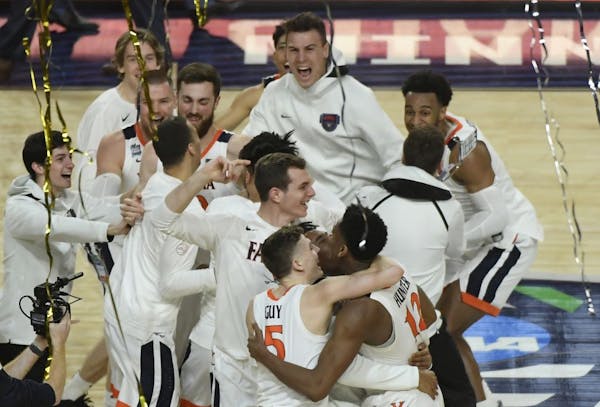Minneapolis is at the leading edge of cellphone technology for the first time. Barely. But it is.
Just as tens of thousands of people were descending on Minneapolis for the Final Four last week, the city became one of the first places in the world to have a fifth-generation, or 5G, wireless network. Data travels four to 10 times faster on 5G than on the 4G networks that have been around about a decade.
The network covers a portion of downtown — including U.S. Bank Stadium, site of the NCAA men's Final Four games — and part of the Mall of America.
Hardly anyone in the basketball throngs knew it or used it, though. As with any big advance in communications networks, this one requires people to have new phones, few of which are available.
But for months, wireless providers have scrambled to appear to be leaders in 5G, sometimes with sped-up offerings that technically were still 4G.
This past week, a pitched PR battle unfolded between Verizon, the largest U.S. wireless carrier, and firms in South Korea.
"There's this whole rush to be first for this and first for that," said Jason Leigh, a telecom industry analyst at IDC, a market research firm.
For Verizon, Minneapolis provided a welcoming environment to quickly install 5G equipment. Because certain types of 5G signals do not travel as far as those in earlier generations, coverage cells are smaller and more equipment has to be installed on rooftops, poles and other high places.
"Minneapolis has been aboard as a city and has been friendly toward the industry in placing small cells," David Weissmann, a Verizon spokesman, said Tuesday.
On light poles around U.S. Bank Stadium, Verizon's 5G equipment is visible as the smaller rectangular antennas above 4G antennas that are longer rectangles.
AT&T, the No. 2 wireless provider, announced in February that it will build 5G cells in Minneapolis-St. Paul this year.
Executives at both firms cited steps by local political leaders to welcome the build-out of 5G networks. The Legislature in 2017 passed a measure allowing the deployment of small-cellular equipment, and the city of Minneapolis aggressively worked on permits for the carriers.
"We had to work to get this new and innovative model set up for small-cell and small-antenna technology," Minneapolis Mayor Jacob Frey said at Verizon 5G's rollout event last Wednesday. "But we worked it through the permitting process with the main intention of getting the technology of course, but also of being first."
Technically, the international telecommunications standard-setting body has not finalized 5G. That will happen next year. But the main specifications were settled in 2017, triggering a rush to market that has played out in extreme ways.
Verizon originally planned to start 5G in Minneapolis and Chicago this week.
But it then began to jockey with South Korea's largest wireless firm, which planned a 5G rollout in a part of Seoul for last Friday. Verizon moved up its launch event to last Wednesday, which led the Korean firm to move its announcement to the same day.
Verizon's relatively small 5G footprint in the two U.S. cities appeared to be bigger than the initial coverage in Seoul. Then on Monday, South Korea's government announced $30 billion in joint government and industry spending to deploy 5G across that country in three years.
It is sure to take longer than that for U.S. carriers, spending chiefly without government assistance, to reach nationwide coverage.
"As much as they're calling these consumer launches, I think [Verizon] is using them to gauge consumer appetite for speed and pricing," IDC's Leigh said. "If you're a consumer going to 5G, it means not only upping your service plan but buying a new device."
The only phone Verizon offers for a 5G network is Motorola's $480 Moto z3, which has to be modified with a $199 antenna and chipset that snaps to the back. The phone and "mod" are available in the company's Twin Cities stores.
For 5G service, Verizon will charge $10 a month more than for 4G.
Verizon also expects to soon offer a 5G smartphone by Samsung, the largest cellphone maker by units. Apple is not expected to offer 5G iPhones until late next year or 2021.
5G users will see the biggest speed difference in data-intensive uses such as video. Picture quality will improve, and waits for downloads or uploads will dramatically shorten.
Minneapolis and Chicago present an opportunity for Verizon to test and overcome weather-related obstacles that are expected to be greater for small-cell areas.
Verizon is currently using about half the bandwidth available to it for 5G in Minneapolis. When it uses the full amount, data speeds will exceed 1 gigabit per second, the speed of fiber-based home internet service, and approach 10 times the 4G maximum of around 150 megabits per second.
Evan Ramstad • 612-673-4241
